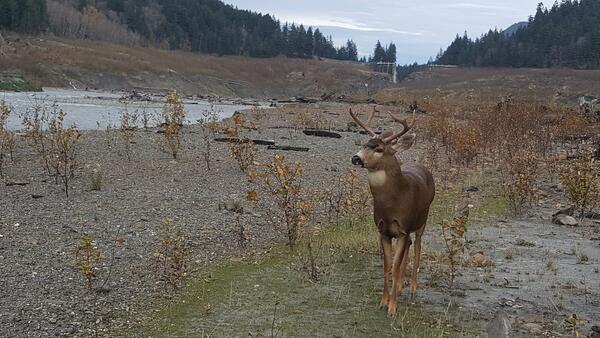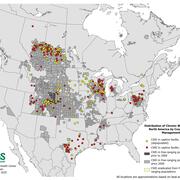Application of a systems approach for management of chronic wasting disease
The USGS National Wildlife Health Center, Montana Cooperative Wildlife Research Unit, Ventana Systems, Inc., and the Wisconsin Department of Natural Resources (WIDNR) are applying a systems approach to map and model the complex relationships among ecological, epidemiological, social, and political processes affecting CWD. Through a participatory modeling process, we gathered subject matter expertise on CWD epidemiology, social science, and deer and forest health and integrated it with empirical data collected by the WIDNR on processes influencing CWD dynamics and management.
What is the issue?

Chronic wasting disease (CWD) is a fatal neurological disease caused by a misfolded protein, or prion, and is found in cervids (e.g., deer, elk, moose). It represents a serious threat to cervid populations and is one of the most important issues in the sustainable management of wild and captive ungulates. However, historic and current CWD intervention efforts have often been hampered by social, economic, and political complexities that are interconnected with the biological and ecological components of the disease.
What is at stake?
Issues associated with CWD can affect many groups, including State agencies, Tribal governments, hunters, biologists, rehabilitators, farmers, and private landowners. All these groups benefit from having healthy cervid populations and can play a role in managing CWD. For example, hunting can be a highly effective method for limiting cervid populations and reducing CWD transmission.
Hunting is an economic engine for the U.S., particularly for rural and Tribal communities, and responsible management of cervid populations directly supports 45.2 billion dollars spent by hunters annually. The conservation and management of game species like wild cervids contributes substantially to the 394.8 billion dollars spent on wildlife-related recreation.
What is our approach?
The USGS National Wildlife Health Center, USGS Montana Cooperative Fish and Wildlife Research Unit, Ventana Systems, Inc., the Wisconsin Department of Natural Resources (WIDNR), and the Missouri Department of Conservation (MODC) are applying a systems approach to map and model the complex relationships among ecological, epidemiological, social, and political processes affecting CWD.
Through a participatory modeling process, our team gathered subject matter expertise on CWD epidemiology, social science, and deer and forest health and integrated it with empirical data collected by the WIDNR and MODC on processes influencing CWD dynamics and management.

What are the next steps?
With our partners, we are actively developing reports on key insights resulting from the model and its predictions about future conditions for cervid and CWD management. To make our model more accessible, we have developed a prototype management flight simulator (Figure 2) that allows natural resource managers and stakeholders to visualize, in real time, both short- and long-term impacts of management decisions on deer population dynamics, disease processes, and stakeholders’ response to management to inform ecological, epidemiological, and social objectives. We are pursuing opportunities to create a refined modeling interface to be used by managers within a decision-making context, so that the model can be used to directly inform strategies for managing cervid populations and CWD.
As we continue to engage with additional management partners, we are focused on incorporating additional social, economic, political, genetic, and forest health dynamics into the model to represent unique management needs and complexities. We are also evaluating opportunities to apply the systems model on a region-wide basis, initially with Midwest Association of Fish & Wildlife Agencies (MAFWA) states and additional jurisdictions, including the Oregon Department of Fish and Wildlife.

Below are other science projects associated with this project.
Assessing the Ability of Incineration to Inactivate CWD Prions from Carcasses
Expanding Distribution of Chronic Wasting Disease
Advancing the Use of RT-QuIC for Applications in CWD Management
Chronic Wasting Disease
Below are partners associated with this project.
The USGS National Wildlife Health Center, Montana Cooperative Wildlife Research Unit, Ventana Systems, Inc., and the Wisconsin Department of Natural Resources (WIDNR) are applying a systems approach to map and model the complex relationships among ecological, epidemiological, social, and political processes affecting CWD. Through a participatory modeling process, we gathered subject matter expertise on CWD epidemiology, social science, and deer and forest health and integrated it with empirical data collected by the WIDNR on processes influencing CWD dynamics and management.
What is the issue?

Chronic wasting disease (CWD) is a fatal neurological disease caused by a misfolded protein, or prion, and is found in cervids (e.g., deer, elk, moose). It represents a serious threat to cervid populations and is one of the most important issues in the sustainable management of wild and captive ungulates. However, historic and current CWD intervention efforts have often been hampered by social, economic, and political complexities that are interconnected with the biological and ecological components of the disease.
What is at stake?
Issues associated with CWD can affect many groups, including State agencies, Tribal governments, hunters, biologists, rehabilitators, farmers, and private landowners. All these groups benefit from having healthy cervid populations and can play a role in managing CWD. For example, hunting can be a highly effective method for limiting cervid populations and reducing CWD transmission.
Hunting is an economic engine for the U.S., particularly for rural and Tribal communities, and responsible management of cervid populations directly supports 45.2 billion dollars spent by hunters annually. The conservation and management of game species like wild cervids contributes substantially to the 394.8 billion dollars spent on wildlife-related recreation.
What is our approach?
The USGS National Wildlife Health Center, USGS Montana Cooperative Fish and Wildlife Research Unit, Ventana Systems, Inc., the Wisconsin Department of Natural Resources (WIDNR), and the Missouri Department of Conservation (MODC) are applying a systems approach to map and model the complex relationships among ecological, epidemiological, social, and political processes affecting CWD.
Through a participatory modeling process, our team gathered subject matter expertise on CWD epidemiology, social science, and deer and forest health and integrated it with empirical data collected by the WIDNR and MODC on processes influencing CWD dynamics and management.

What are the next steps?
With our partners, we are actively developing reports on key insights resulting from the model and its predictions about future conditions for cervid and CWD management. To make our model more accessible, we have developed a prototype management flight simulator (Figure 2) that allows natural resource managers and stakeholders to visualize, in real time, both short- and long-term impacts of management decisions on deer population dynamics, disease processes, and stakeholders’ response to management to inform ecological, epidemiological, and social objectives. We are pursuing opportunities to create a refined modeling interface to be used by managers within a decision-making context, so that the model can be used to directly inform strategies for managing cervid populations and CWD.
As we continue to engage with additional management partners, we are focused on incorporating additional social, economic, political, genetic, and forest health dynamics into the model to represent unique management needs and complexities. We are also evaluating opportunities to apply the systems model on a region-wide basis, initially with Midwest Association of Fish & Wildlife Agencies (MAFWA) states and additional jurisdictions, including the Oregon Department of Fish and Wildlife.

Below are other science projects associated with this project.
Assessing the Ability of Incineration to Inactivate CWD Prions from Carcasses
Expanding Distribution of Chronic Wasting Disease
Advancing the Use of RT-QuIC for Applications in CWD Management
Chronic Wasting Disease
Below are partners associated with this project.





